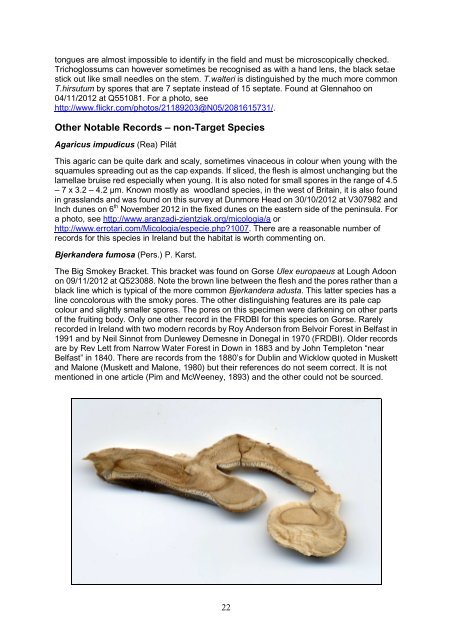North Kerry Waxcap Survey 2012 - the Northern Ireland Fungus Group
North Kerry Waxcap Survey 2012 - the Northern Ireland Fungus Group
North Kerry Waxcap Survey 2012 - the Northern Ireland Fungus Group
You also want an ePaper? Increase the reach of your titles
YUMPU automatically turns print PDFs into web optimized ePapers that Google loves.
tongues are almost impossible to identify in <strong>the</strong> field and must be microscopically checked.<br />
Trichoglossums can however sometimes be recognised as with a hand lens, <strong>the</strong> black setae<br />
stick out like small needles on <strong>the</strong> stem. T.walteri is distinguished by <strong>the</strong> much more common<br />
T.hirsutum by spores that are 7 septate instead of 15 septate. Found at Glennahoo on<br />
04/11/<strong>2012</strong> at Q551081. For a photo, see<br />
http://www.flickr.com/photos/21189203@N05/2081615731/.<br />
O<strong>the</strong>r Notable Records – non-Target Species<br />
Agaricus impudicus (Rea) Pilát<br />
This agaric can be quite dark and scaly, sometimes vinaceous in colour when young with <strong>the</strong><br />
squamules spreading out as <strong>the</strong> cap expands. If sliced, <strong>the</strong> flesh is almost unchanging but <strong>the</strong><br />
lamellae bruise red especially when young. It is also noted for small spores in <strong>the</strong> range of 4.5<br />
– 7 x 3.2 – 4.2 µm. Known mostly as woodland species, in <strong>the</strong> west of Britain, it is also found<br />
in grasslands and was found on this survey at Dunmore Head on 30/10/<strong>2012</strong> at V307982 and<br />
Inch dunes on 6 th November <strong>2012</strong> in <strong>the</strong> fixed dunes on <strong>the</strong> eastern side of <strong>the</strong> peninsula. For<br />
a photo, see http://www.aranzadi-zientziak.org/micologia/a or<br />
http://www.errotari.com/Micologia/especie.php?1007. There are a reasonable number of<br />
records for this species in <strong>Ireland</strong> but <strong>the</strong> habitat is worth commenting on.<br />
Bjerkandera fumosa (Pers.) P. Karst.<br />
The Big Smokey Bracket. This bracket was found on Gorse Ulex europaeus at Lough Adoon<br />
on 09/11/<strong>2012</strong> at Q523088. Note <strong>the</strong> brown line between <strong>the</strong> flesh and <strong>the</strong> pores ra<strong>the</strong>r than a<br />
black line which is typical of <strong>the</strong> more common Bjerkandera adusta. This latter species has a<br />
line concolorous with <strong>the</strong> smoky pores. The o<strong>the</strong>r distinguishing features are its pale cap<br />
colour and slightly smaller spores. The pores on this specimen were darkening on o<strong>the</strong>r parts<br />
of <strong>the</strong> fruiting body. Only one o<strong>the</strong>r record in <strong>the</strong> FRDBI for this species on Gorse. Rarely<br />
recorded in <strong>Ireland</strong> with two modern records by Roy Anderson from Belvoir Forest in Belfast in<br />
1991 and by Neil Sinnot from Dunlewey Demesne in Donegal in 1970 (FRDBI). Older records<br />
are by Rev Lett from Narrow Water Forest in Down in 1883 and by John Templeton “near<br />
Belfast” in 1840. There are records from <strong>the</strong> 1880’s for Dublin and Wicklow quoted in Muskett<br />
and Malone (Muskett and Malone, 1980) but <strong>the</strong>ir references do not seem correct. It is not<br />
mentioned in one article (Pim and McWeeney, 1893) and <strong>the</strong> o<strong>the</strong>r could not be sourced.<br />
22


